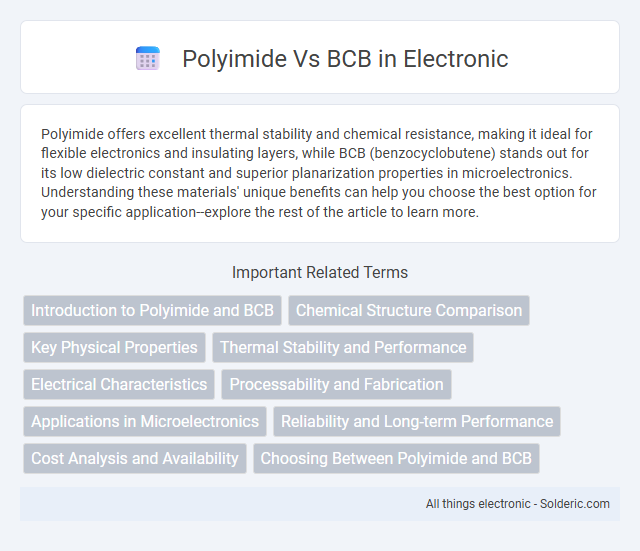Polyimide offers excellent thermal stability and chemical resistance, making it ideal for flexible electronics and insulating layers, while BCB (benzocyclobutene) stands out for its low dielectric constant and superior planarization properties in microelectronics. Understanding these materials' unique benefits can help you choose the best option for your specific application--explore the rest of the article to learn more.
Comparison Table
| Property | Polyimide | Benzocyclobutene (BCB) |
|---|---|---|
| Chemical Structure | Polyimide is a polymer with imide linkages. | BCB is a polymer with benzocyclobutene rings. |
| Dielectric Constant | ~3.2 - 3.5 | ~2.6 - 2.7 (Lower dielectric constant) |
| Thermal Stability | High, stable up to 400 degC | Moderate, stable up to 250 degC |
| Mechanical Properties | Good flexibility and toughness | Good planarization, less flexible |
| Curing Temperature | 250 - 350 degC | ~200 degC |
| Moisture Absorption | Moderate (up to 3%) | Low (less than 0.1%) |
| Applications | Microelectronics, flexible circuits, insulation layers | Microelectronics, photonics, low-k dielectric layers |
| Cost | Generally lower cost | Higher cost due to specialized processing |
Introduction to Polyimide and BCB
Polyimide is a high-performance polymer known for its excellent thermal stability, chemical resistance, and mechanical strength, widely used in microelectronics and flexible circuitry. Benzocyclobutene (BCB) is a thermosetting polymer characterized by low dielectric constant and superior planarization properties, making it ideal for advanced semiconductor applications. Both materials serve critical roles in electronic packaging, with polyimide favored for durability and BCB for low-k dielectric insulation.
Chemical Structure Comparison
Polyimide features a rigid aromatic backbone with imide linkages, offering exceptional thermal stability and mechanical strength. Benzocyclobutene (BCB) contains a bicyclic benzocyclobutene ring structure that enables low dielectric constant and excellent planarization properties ideal for microelectronics. Understanding the distinct chemical structures of your chosen material helps optimize performance in high-frequency and flexible electronic applications.
Key Physical Properties
Polyimide exhibits excellent thermal stability up to 400degC and a high tensile strength of approximately 150 MPa, making it ideal for demanding semiconductor and aerospace applications. Benzocyclobutene (BCB) offers lower dielectric constant values around 2.65 and superior planarization properties, enhancing signal integrity in high-frequency circuits. Your choice between Polyimide and BCB depends on whether thermal resistance or electrical performance is more critical for your project.
Thermal Stability and Performance
Polyimide exhibits exceptional thermal stability, maintaining structural integrity at temperatures up to 400degC, making it ideal for high-performance electronic and aerospace applications. Benzocyclobutene (BCB) offers lower thermal stability, with optimal performance generally below 300degC, but it excels in low dielectric constant and planarization properties beneficial for microelectronics fabrication. The choice between polyimide and BCB depends on thermal endurance requirements, with polyimide preferred for high-temperature environments and BCB favored for applications prioritizing electrical performance and process compatibility.
Electrical Characteristics
Polyimide offers excellent electrical insulation with a dielectric constant typically around 3.4 to 3.5 and high breakdown voltage, making it ideal for flexible circuits and microelectronics. Benzocyclobutene (BCB) features a lower dielectric constant of about 2.6 to 2.7, providing superior signal speed and reduced crosstalk in high-frequency applications such as RF devices and advanced semiconductor packaging. Your choice depends on the need for thermal stability and mechanical flexibility versus ultra-low dielectric properties for optimal electrical performance.
Processability and Fabrication
Polyimide offers excellent thermal stability and mechanical strength, making it suitable for high-temperature processing and flexible electronics fabrication. BCB (benzocyclobutene) provides superior planarization and low dielectric constant, enabling easier integration in multi-level metal interconnects with reduced signal loss. Your choice between polyimide and BCB should consider the specific fabrication process requirements, with polyimide excelling in robust mechanical environments and BCB optimized for advanced microelectronic layering and low stress deposition.
Applications in Microelectronics
Polyimide and BCB are widely used dielectric materials in microelectronics, each offering distinct advantages for specific applications. Polyimide excels in flexible circuits, chip packaging, and insulation due to its superior thermal stability and mechanical strength. BCB, favored for its low dielectric constant and excellent planarization properties, enhances high-frequency performance in radio frequency (RF) devices and advanced semiconductor interconnects, ensuring your microelectronic designs meet rigorous electrical and reliability standards.
Reliability and Long-term Performance
Polyimide exhibits exceptional thermal stability and chemical resistance, making it highly reliable for long-term electronic and semiconductor applications where durability is critical. BCB (Benzocyclobutene) offers excellent dielectric properties and low moisture absorption but may have limitations in extreme thermal environments compared to polyimide. Your choice between polyimide and BCB depends on the specific reliability requirements and operating conditions of your device over its expected lifespan.
Cost Analysis and Availability
Polyimide offers a cost-effective solution with widespread availability due to its established manufacturing processes and numerous suppliers, making it accessible for various applications. Benzocyclobutene (BCB), while superior in certain performance aspects, tends to be more expensive and less readily available because of its specialized production requirements and limited vendor options. Your choice between Polyimide and BCB will depend on balancing budget constraints with material performance needs.
Choosing Between Polyimide and BCB
Choosing between Polyimide and BCB depends largely on your application's thermal stability and dielectric properties; Polyimide offers excellent heat resistance up to 400degC, while BCB provides superior low-k dielectric performance and excellent chemical resistance. For high-frequency electronics or photonics, BCB's low dielectric constant and planarization capabilities make it favorable, whereas Polyimide is preferred in flexible electronics and insulation layering due to its mechanical robustness. Evaluating your device's operating environment and required electrical insulation will guide the optimal choice between these materials.
Polyimide vs BCB Infographic

 solderic.com
solderic.com